A Multi-Objective Train Operational Plan Optimization Approach for Adding Additional Trains on a High-Speed Railway Corridor in Peak Periods
Abstract
1. Introduction
1.1. Background and Motivation
1.2. Literature Review
1.3. Contribution
2. Problem Description
3. Formulation
- The traveling time of each segment is fixed.
- The capacity of the station and the rolling stocks is unlimited.
- Dwelling time at the origin station and terminal station of the trip for each train is not considered.
- The difference between the infrastructure of stations is not considered. In the real word, the infrastructure in some small-scale stations is so poor that they are not suitable to serve as an origin station or terminal station. In this paper, we assume that all stations are qualified to serve as an origin station or terminal station for additional trains.
3.1. Decision Variables
3.2. Formulations of Constraints
3.2.1. Constraints of Operational Zone
3.2.2. Constraints of Timetable
3.2.3. Constraints of Stop Plan
3.2.4. Passenger Demand Constraints
3.2.5. Loading Capacity Constraints
3.3. Objective Functions
4. Solution Technique
4.1. Reformulations for Nonlinear Constraints
4.2. Multi-Objective Analysis
5. Numerical Experiments
5.1. Small-Scale Case Study
5.2. Additional Experiments
5.3. Large-Scale Case Study
6. Conclusions
Author Contributions
Funding
Conflicts of Interest
References
- The 2018 Statistical Communique on the Development of the Transport Industry. Available online: http://xxgk.mot.gov.cn/jigou/zhghs/201904/t20190412_3186720.html (accessed on 12 October 2019).
- Burdett, R.L.; Kozan, E. Techniques for inserting additional trains into existing timetables. Transp. Res. Part B 2009, 43, 821–836. [Google Scholar] [CrossRef]
- Cacchiani, V.; Caprara, A.; Toth, P. Scheduling extra freight trains on railway networks. Transp. Res. Part B 2010, 44, 215–231. [Google Scholar] [CrossRef]
- Gao, Y.; Kroon, L.; Yang, L.; Gao, Z. Three-stage optimization method for the problem of scheduling additional trains on a high-speed rail corridor. Omega 2017, 30, 175–191. [Google Scholar] [CrossRef]
- Liu, Y.; Cao, C.; Feng, Z.; Zhou, Y. A Cost and Passenger Responsible Optimization Method for the Operation Plan of Additional High-Speed Trains in a Peak Period. J. Adv. Transp. 2020, 2020, 3602727. [Google Scholar] [CrossRef]
- Caprara, A.; Kroon, L.G.; Monaci, M.; Peeters, M.; Toth, P. Passenger Railway Optimization. In Handbooks in Operations Research and Management Science; Elsevier: Amsterdam, The Netherlands, 2007; Volume 14, pp. 129–187. [Google Scholar]
- Bussieck, M.R.; Kreuzer, P.; Zimmermann, U.T. Optimal lines for railway systems. Eur. J. Oper. Res. 1996, 96, 54–63. [Google Scholar] [CrossRef]
- Claessens, M.T.; van Dijk, N.M.; Zwaneveld, P.J. Cost optimal allocation of passenger lines. Eur. J. Oper. Res. 1998, 110, 474–489. [Google Scholar] [CrossRef]
- Chang, Y.H.; Yeh, C.H.; Shen, C.C. A multi-objective model for passenger train services planning application to Taiwan’s high-speed rail line. Transp. Res. Part B 2000, 34, 91–106. [Google Scholar] [CrossRef]
- Goossens, J.W.; Hoesel, S.V.; Kroon, L. A branch-cut approach for solving railway line-planning problems. Transp. Sci. 2004, 38, 379–393. [Google Scholar] [CrossRef]
- Goossens, J.W.; Hoesel, S.V.; Kroon, L. On solving multi-type railway line planning problems. Eur. J. Oper. Res. 2005, 168, 403–424. [Google Scholar] [CrossRef]
- Scholl, S. Customer-Oriented Line Planning. Ph.D. Thesis, Universitaet at Goettingen, Goettingen, Germany, 2005. [Google Scholar]
- Szpigel, B. Optimal train scheduling on a single-track railway. Oper. Res. 1973, 72, 343–352. [Google Scholar]
- Caprara, A.; Fischetti, M.; Toth, P. Modeling and solving the train timetabling problem. Oper. Res. 2002, 50, 851–861. [Google Scholar] [CrossRef]
- Caprara, A.; Monaci, M.; Toth, P.; Guida, P.L. A Lagrangian heuristic algorithm for a real-world train timetabling problem. Discret. Appl. Math. 2006, 154, 738–753. [Google Scholar] [CrossRef]
- Higgins, A.; Kozan, E.; Ferreira, L. Optimal scheduling of trains on a single line track. Transp. Res. Part B 1996, 30, 147–161. [Google Scholar] [CrossRef]
- Higgins, A.; Kozan, E. Modeling train delays in urban networks. Transp. Sci. 1998, 32, 346–357. [Google Scholar] [CrossRef]
- Şahin, İ. Railway traffic control and train scheduling based on inter-train conflict management. Transp. Res. Part B 1999, 33, 511–534. [Google Scholar] [CrossRef]
- D’Ariano, A.; Pacciarelli, D.; Pranzo, M. Assessment of flexible timetables in real-time traffic management of a railway bottleneck. Transp. Res. Part C 2008, 16, 232–245. [Google Scholar] [CrossRef]
- Canca, D.; Barrena, E.; Algaba, E.; Zarzo, A. Design and analysis of demand-adapted railway timetables. J. Adv. Transp. 2014, 48, 119–137. [Google Scholar] [CrossRef]
- Barrena, E.; Canca, D.; Coelho, L.C.; Laporte, G. Single-line rail rapid transit timetabling under dynamic passenger demand. Transp. Res. Part B 2014, 70, 134–150. [Google Scholar] [CrossRef]
- Sun, L.; Jin, J.G.; Lee, D.H.; Axhausen, K.W.; Erath, A. Demand-driven timetable design for metro services. Transp. Res. Part C 2014, 46, 284–299. [Google Scholar] [CrossRef]
- Zhang, T.; Li, D.; Qiao, Y. Comprehensive Optimization of Urban Rail Transit Timetable by Minimizing Total Travel Times under Time-dependent Passenger Demand and Congested Conditions. Appl. Math. Model. 2018, 58, 421–446. [Google Scholar] [CrossRef]
- Robenek, T.; Azadeh, S.S.; Maknoon, Y.; De Lapparent, M.; Bierlaire, M. Train timetable design under elastic passenger demand. Transp. Res. Part B 2018, 111, 19–38. [Google Scholar] [CrossRef]
- Fu, H.; Sperry, B.R.; Nie, L. Operational impacts of using restricted passenger flow assignment in high-speed train stop scheduling problem. Math. Probl. Eng. 2013, 78, 143–175. [Google Scholar] [CrossRef]
- Chen, D.; Ni, S.; Xu, C.A.; Lv, H.; Wang, S. High-Speed Train Stop-Schedule Optimization Based on Passenger Travel Convenience. Math. Probl. Eng. 2016, 2016, 8763589. [Google Scholar] [CrossRef]
- Qi, J.; Li, S.; Gao, Y.; Yang, K.; Liu, P. Joint optimization model for train scheduling and train stop planning with passengers distribution on railway corridors. J. Oper. Res. Soc. 2018, 69, 556–570. [Google Scholar] [CrossRef]
- Qi, J.; Yang, L.; Di, Z.; Li, S.; Yang, K.; Gao, Y. Integrated optimization for train operation zone and stop plan with passenger distributions. Transp. Res. Part E 2018, 109, 151–173. [Google Scholar] [CrossRef]
- Yi, M. Optimization Research on Beijing-Shanghai Stop Schedule Plan of High-Speed Railway. Master’s Thesis, Southwest Jiaotong University, Chengdu, China, 2005. [Google Scholar]
- Yang, L.; Qi, J.; Li, S.; Gao, Y. Collaborative optimization for train scheduling and train stop planning on high-speed railways. Omega 2016, 64, 57–76. [Google Scholar] [CrossRef]

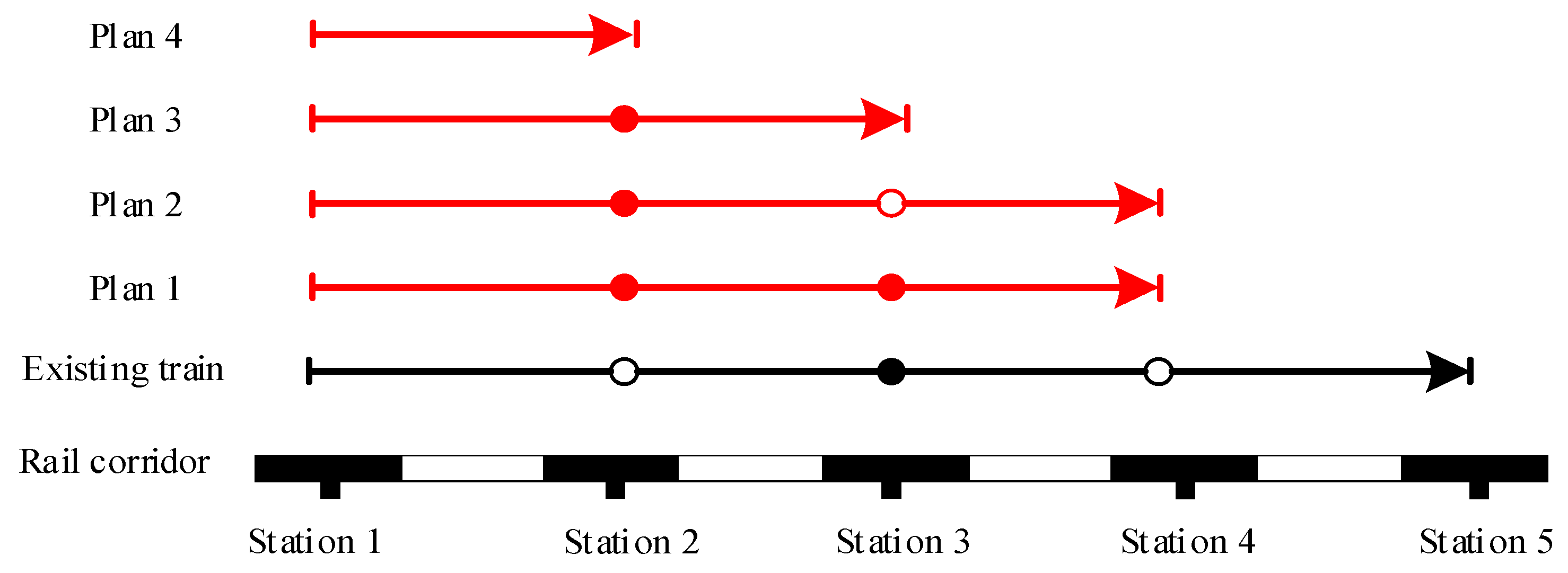

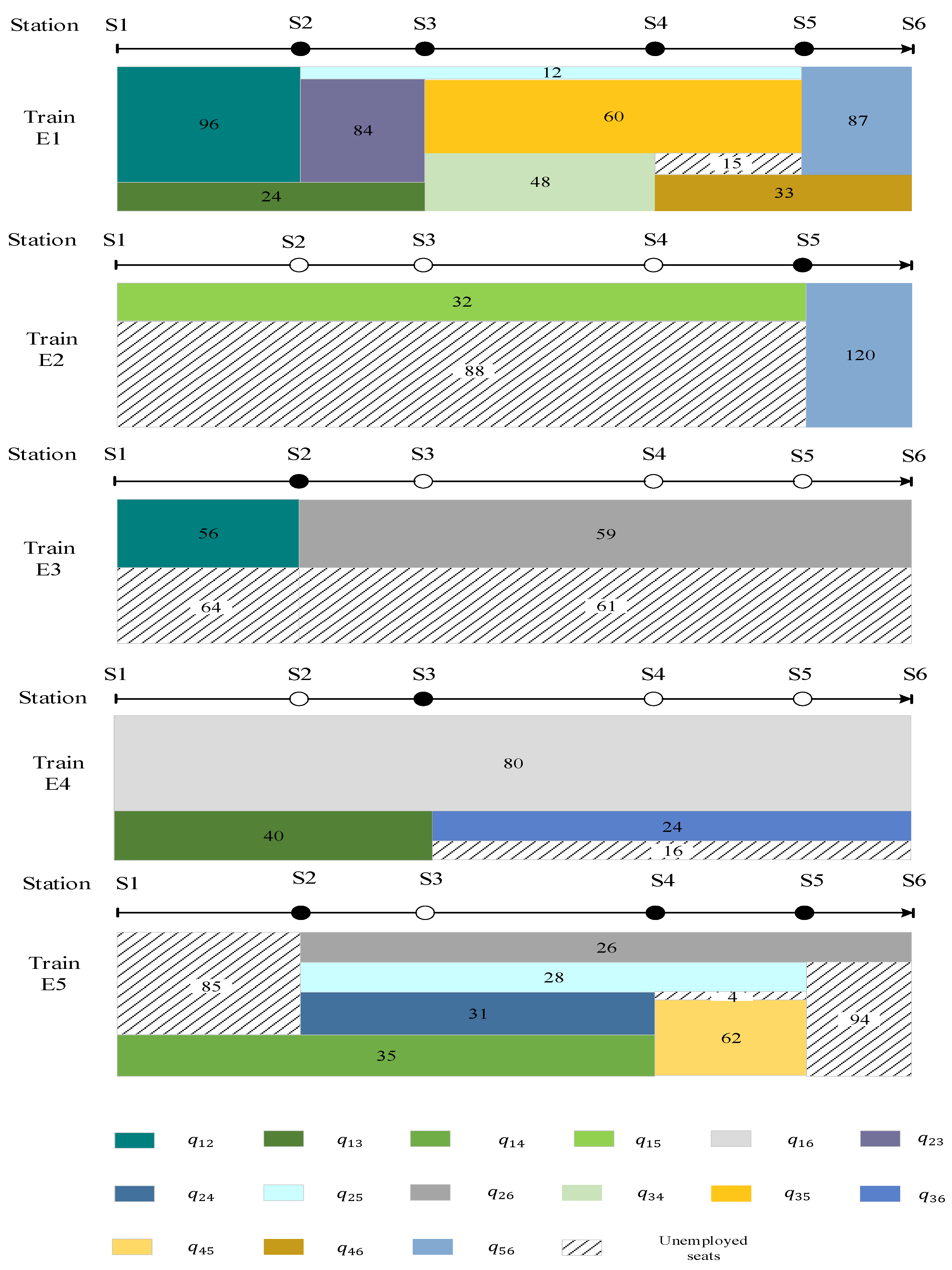
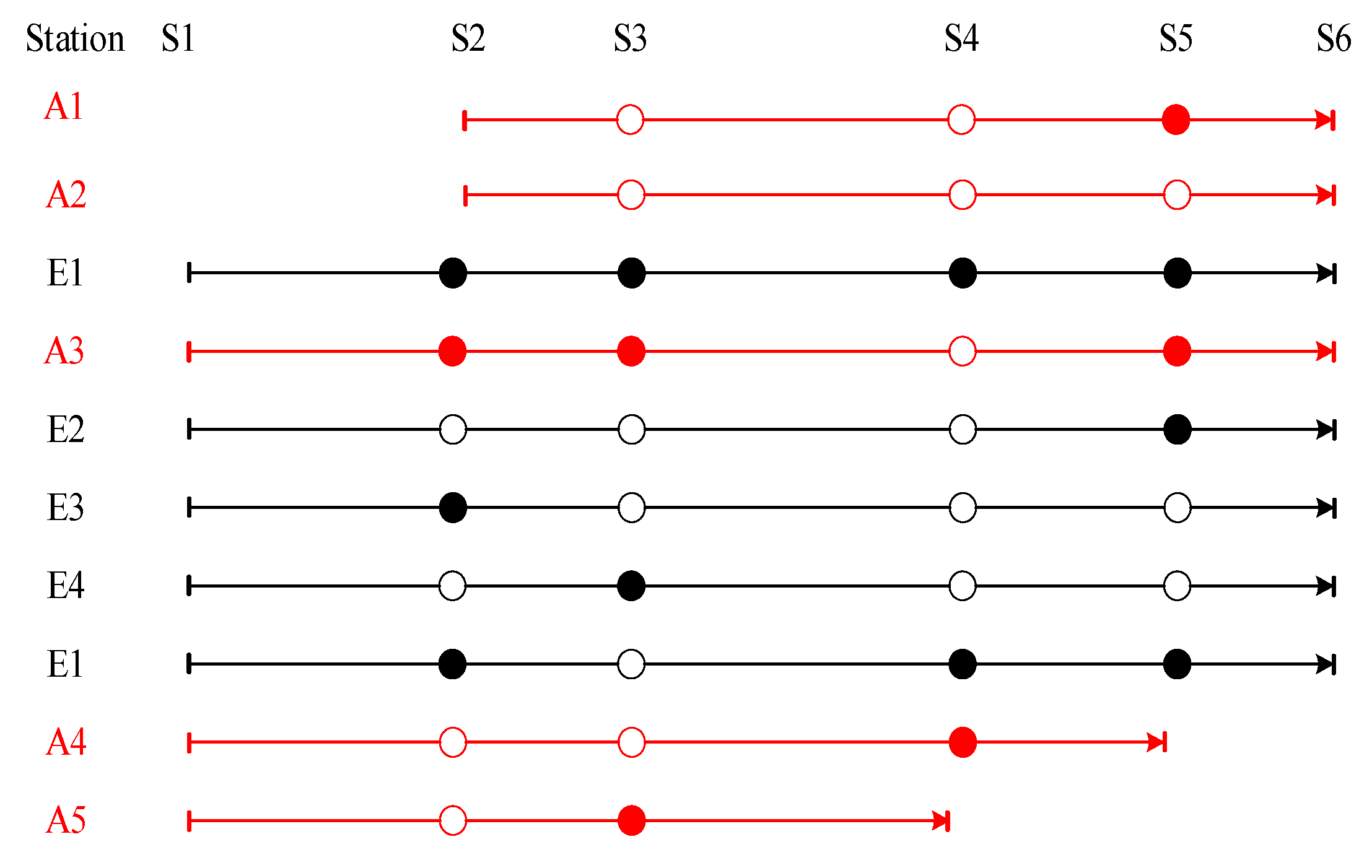

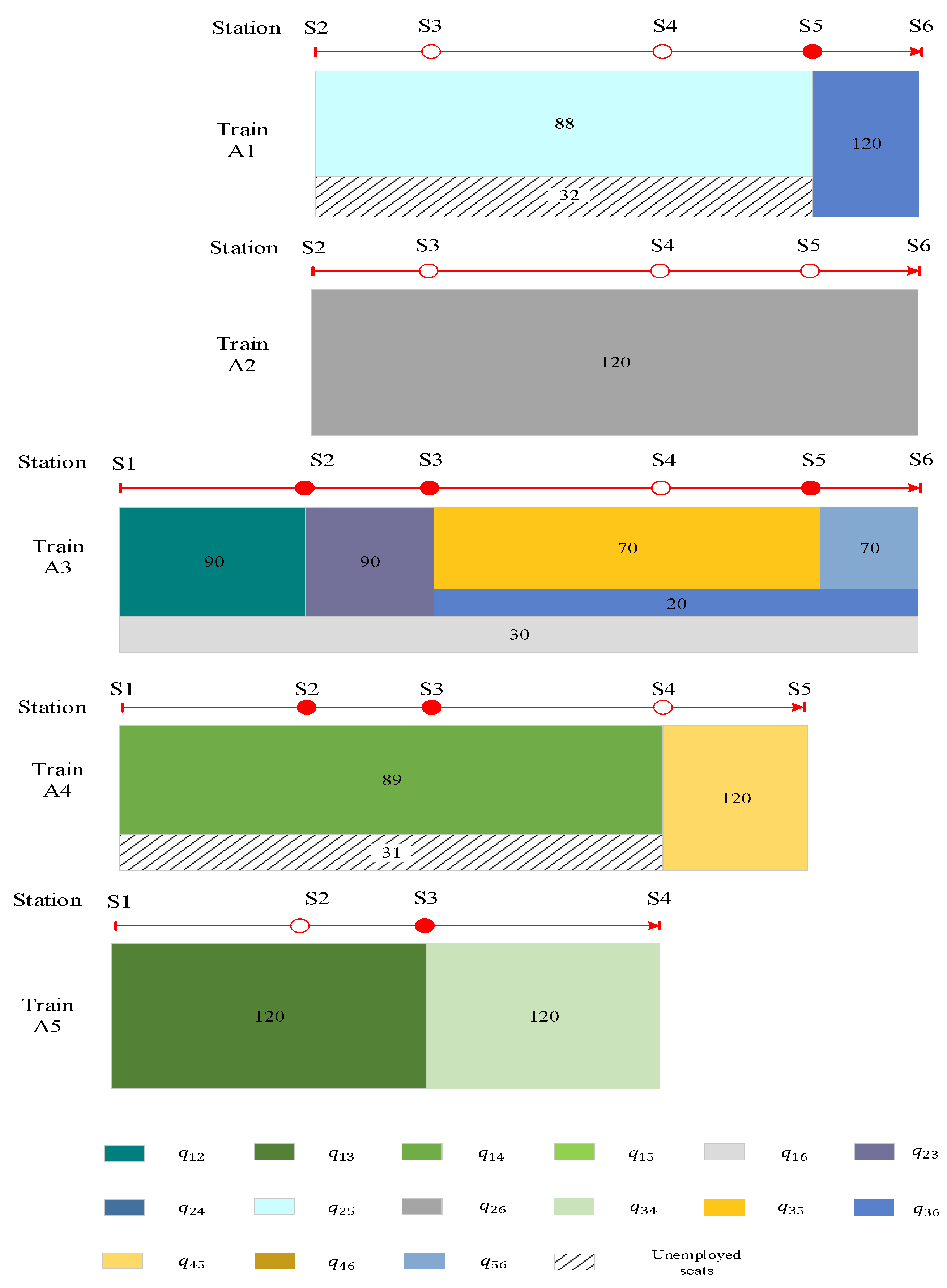

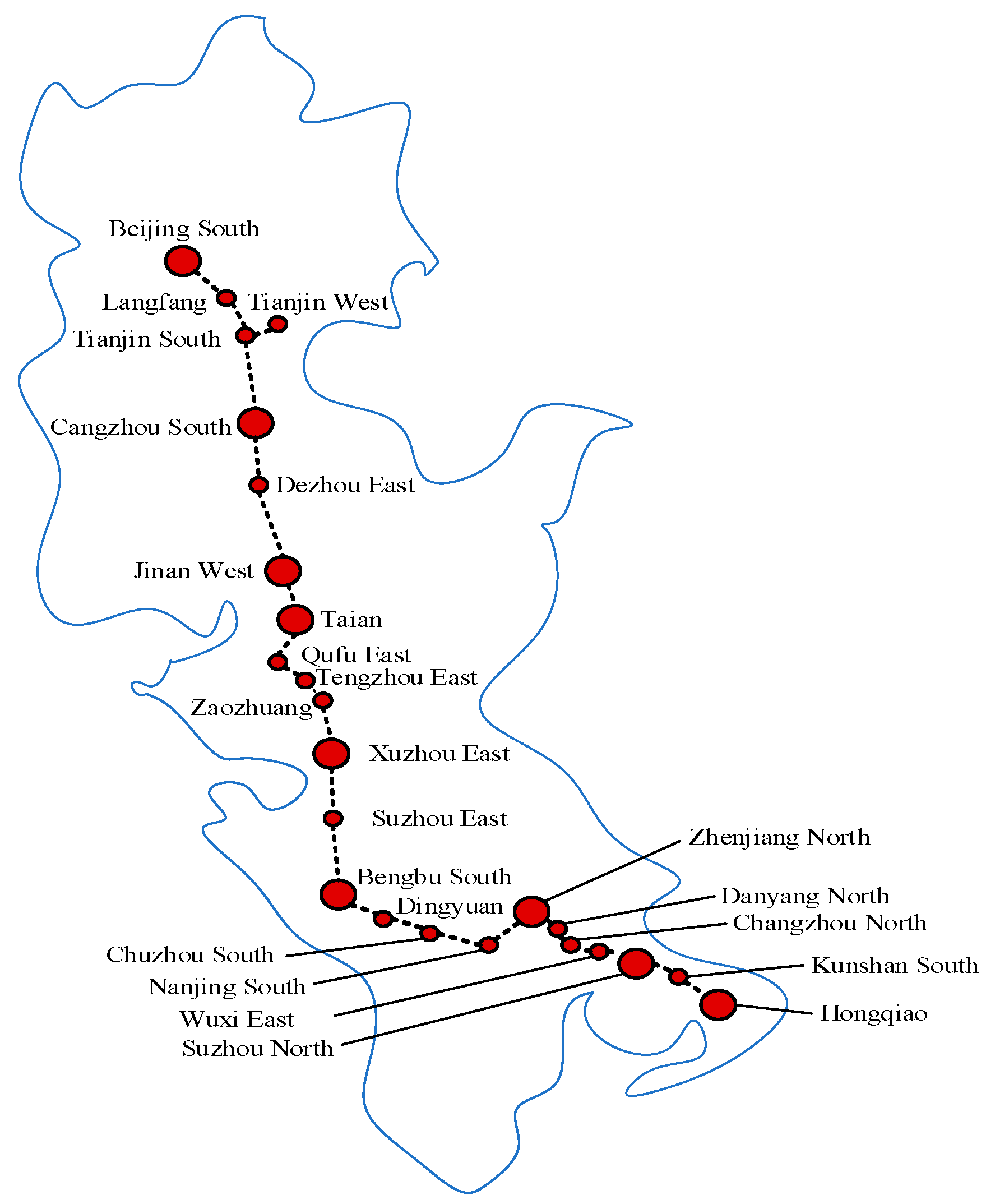
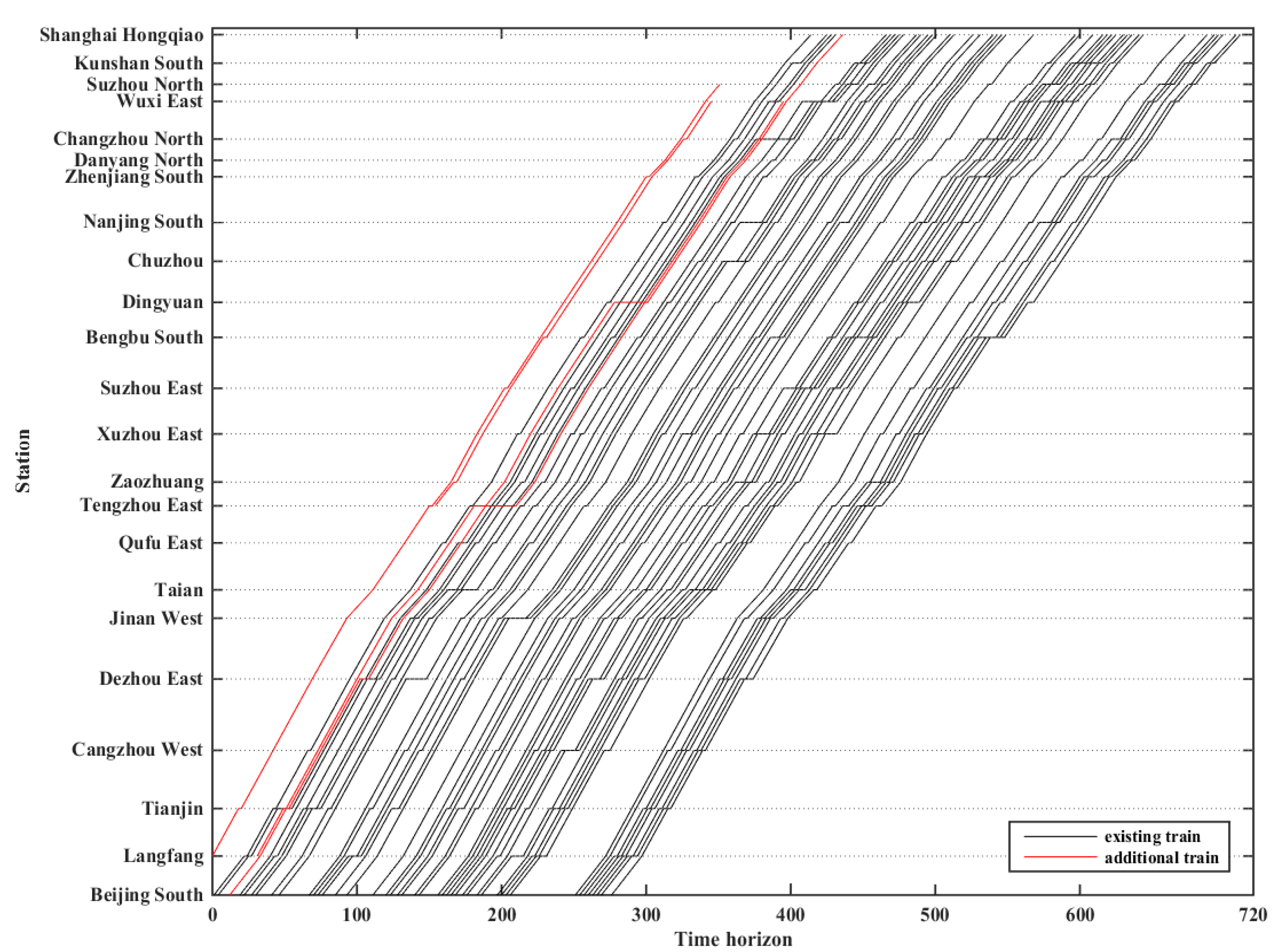
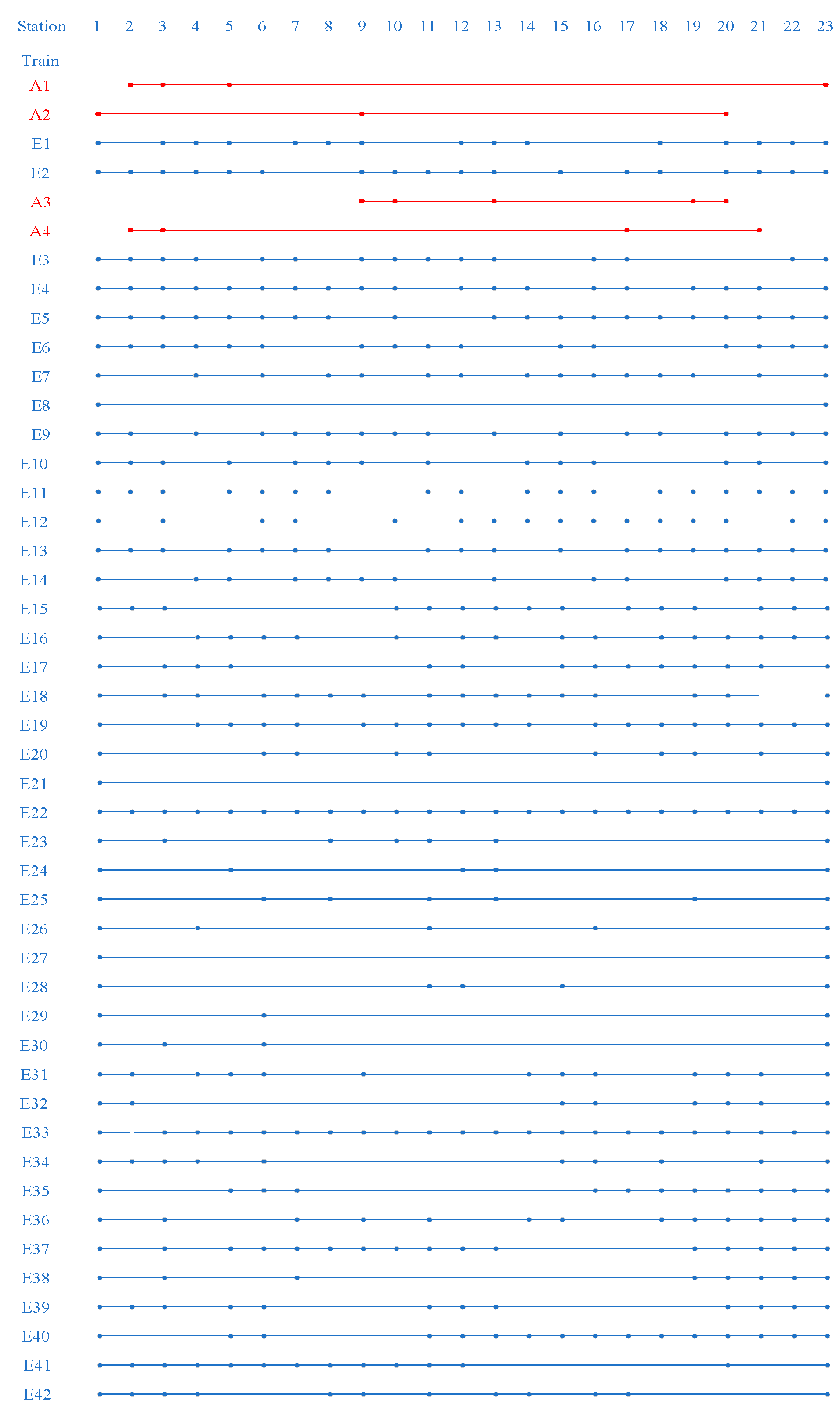
| Origin/Terminal Station | 1 | 2 | 3 | 4 | 5 |
|---|---|---|---|---|---|
| 1 | N | N | |||
| 2 | N | ||||
| 3 | N |
| Operation Zone | Operational Cost | Loading Passengers | Unsatisfied Passenger Demand |
|---|---|---|---|
| Off-peak | |||
| Plan 1 | |||
| Plan 2 | 0 | ||
| Plan 3 | |||
| Plan 4 |
| Notions | Definitions |
|---|---|
| Set of stations | |
| The set of traveling time of segments. | |
| The set of existing trains | |
| The set of expected additional trains | |
| The time window of additional train arrives at its terminal station | |
| The index of station, . | |
| The index of OD pair, . | |
| The index of segment on the railway corridor, | |
| The traveling time of train on the segment | |
| The distance from stationto station 1 | |
| The index of train, | |
| The minimum headway of trains | |
| The minimum dwelling time | |
| The maximum dwelling time | |
| The departure time of existing train at station , . | |
| The arrival time of existing train at station ,. | |
| Indicator for station as origin station of existing train for: if train select station as its origin station, = 0 otherwise. | |
| Indicator for station as terminal station for existing train : if train select station as its origin station, = 0 otherwise. | |
| Indicator for existing train stopping at station : if train stop at station , = 0 otherwise. | |
| The maximum loading capacity of train | |
| The required minimum number of boarding and alighting passengers for train stopping. | |
| Passenger demand for OD pair | |
| The total outbound passenger demand along the whole railway corridor | |
| The number of existing trains | |
| The expected number of additional trains | |
| The number of additional trains |
| Variables | Definitions |
|---|---|
| selection indicator for adding additional train : if train is added in peak period, otherwise; | |
| selection indicator for the departure order of train and train at station .=1 if train depart from station earlier than train before, =0 otherwise. | |
| selection indicator for stop plan for additional train for station :=1 if train stop at station , otherwise. | |
| selection indicator for origin station for additional train for station : if train select train as its origin station, = 0 otherwise. | |
| selection indicator for terminal station additional train for station : if train select train as its terminal station, = 0 otherwise; | |
| departure time of train at station , where and . | |
| arrival time of train at station, where and | |
| the number of passengers take additional train from station to station ,. | |
| the number of passengers take existing train from station to station in peak period,. |
| Original Nonlinear Constraints | Reformulated Linear Constraints |
|---|---|
| Constraints (4)~(5) | Constraints (43) and (44) |
| Constraints (7)~(11) | Constraints (45)~(49) |
| Constraints (12) | Constraints (50) and (51) |
| Constraints (13) and (14) | Constraints (52) and (53) |
| Constraints (15) | Constraints (54)~constraints (59) |
| Constraints (16)~(21) | Constraints (60) ~(65) |
| Constraints (24) and (25) | Constraints (66) and (67) |
| Origin\Terminal Station | S1 | S2 | S3 | S4 | S5 | S6 | Total |
|---|---|---|---|---|---|---|---|
| S1 | - | 380 | 160 | 89 | 82 | 200 | 911 |
| S2 | - | - | 210 | 79 | 102 | 214 | 605 |
| S3 | - | - | - | 120 | 150 | 60 | 330 |
| S4 | - | - | - | - | 157 | 83 | 240 |
| S5 | - | - | - | - | - | 521 | 411 |
| Total | - | 380 | 370 | 288 | 491 | 1078 | 2607 |
| The Number of Trains | Running Distance | Dwelling Time | The Number of Stops | Unsatisfied Passengers | |
|---|---|---|---|---|---|
| 0.5 | 5 | 750 | 10 | 4 | 17 |
| 0.6 | 5 | 750 | 11 | 5 | 17 |
| 0.7 | 5 | 750 | 11 | 5 | 17 |
| 0.8 | 5 | 750 | 12 | 6 | 17 |
| 0.9 | 4 | 600 | 5 | 5 | 208 |
| 1.0 | 4 | 576 | 5 | 5 | 207 |
| The Number of Trains | Running Distance | Dwelling Time | The Number of Stops | Unsatisfied Passengers | |
|---|---|---|---|---|---|
| 1 | 5 | 750 | 12 | 6 | 17 |
| 2 | 5 | 750 | 17 | 4 | 31 |
| 3 | 5 | 690 | 22 | 3 | 141 |
| 4 | 5 | 690 | 22 | 2 | 154 |
| 5 | 5 | 690 | 25 | 2 | 154 |
| The Number of Trains | Running Distance | Dwelling Time | The Number of Stops | Unsatisfied Passengers | |
|---|---|---|---|---|---|
| 1 | 5 | 750 | 9 | 6 | 17 |
| 2 | 5 | 750 | 12 | 6 | 17 |
| 3 | 5 | 654 | 7 | 5 | 139 |
| 4 | 4 | 468 | 6 | 4 | 259 |
| 5 | 4 | 468 | 5 | 3 | 261 |
| The Number of Trains | Running Distance | Dwelling Time | The Number of Stops | Unsatisfied Passengers | |
|---|---|---|---|---|---|
| 10 | 5 | 750 | 12 | 6 | 17 |
| 20 | 5 | 750 | 12 | 6 | 17 |
| 30 | 5 | 750 | 12 | 6 | 17 |
| 40 | 5 | 750 | 11 | 5 | 32 |
| 50 | 5 | 750 | 11 | 5 | 32 |
| 60 | 5 | 690 | 5 | 4 | 142 |
| 70 | 5 | 690 | 5 | 4 | 142 |
| 80 | 5 | 690 | 5 | 4 | 142 |
| 90 | 4 | 600 | 4 | 3 | 210 |
| 100 | 4 | 576 | 3 | 2 | 252 |
| Segment | Distance (km) | Traveling Time (min) |
|---|---|---|
| Beijing South-Langfang | 59 | 21 |
| Langfang-Tianjin | 72 | 18 |
| Tianjin South-Cangzhou West | 88 | 22 |
| Cangzhou West-Dezhou East | 108 | 27 |
| Dezhou East-Jinan West | 92 | 24 |
| Jinan West-Taian | 43 | 18 |
| Taian-Qufu East | 71 | 22 |
| Qufu East-Tengzhou | 56 | 17 |
| Tengzhou-Zhaozhuang | 36 | 13 |
| Zhaozhuang-Xuzhou East | 63 | 18 |
| Xuzhou East-Suzhou East | 79 | 19 |
| Suzhou East-Bengbu South | 77 | 23 |
| Bengbu South-Dingyuan | 53 | 16 |
| Dingyuan-Chuzhou | 62 | 19 |
| Chuzhou-Nanjing South | 59 | 18 |
| Nanjing South-Zhenjiang South | 69 | 20 |
| Zhenjiang South-Danyang North | 25 | 11 |
| Danyang North-Changzhou North | 32 | 11 |
| Changzhou North-Wuxi East | 57 | 17 |
| Wuxi East-Suzhou North | 26 | 10 |
| Suzhou North-Kunshan South | 32 | 11 |
| Kunshan South-Hongqiao | 43 | 18 |
| Origin/Terminal Station | Beijing South | Langfang | Tianjin | Cangzhou West | Dezhou East | Jinan West | Taian | Qufu East | Tengzhou | Zhaozhuang | Xuzhou East | Suzhou East |
| Beijing South | _ | 701 | 4427 | 1863 | 1490 | 3901 | 1512 | 2016 | 273 | 438 | 2696 | 460 |
| Langfang | _ | _ | 832 | 548 | 350 | 350 | 98 | 100 | 69 | 104 | 121 | 100 |
| Tianjin | _ | _ | _ | 1315 | 1424 | 2301 | 613 | 1424 | 176 | 328 | 2235 | 240 |
| Cangzhou West | _ | _ | _ | _ | 219 | 394 | 88 | 88 | 10 | 44 | 196 | 21 |
| Dezhou East | _ | _ | _ | _ | _ | 832 | 284 | 352 | 44 | 219 | 219 | 112 |
| Jinan West | _ | _ | _ | _ | _ | _ | 1183 | 1140 | 56 | 1227 | 1030 | 73 |
| Taian | _ | _ | _ | _ | _ | _ | _ | 284 | 42 | 307 | 723 | 108 |
| Qufu East | _ | _ | _ | _ | _ | _ | _ | _ | 28 | 175 | 219 | 438 |
| Tengzhou | _ | _ | _ | _ | _ | _ | _ | _ | _ | 52 | 125 | 53 |
| Zhaozhuang | _ | _ | _ | _ | _ | _ | _ | _ | _ | _ | 394 | 284 |
| Xuzhou East | _ | _ | _ | _ | _ | _ | _ | _ | _ | _ | _ | 416 |
| Suzhou East | _ | _ | _ | _ | _ | _ | _ | _ | _ | _ | _ | _ |
| (a) | ||||||||||||
| Origin/Desitination | Bengbu South | Dingyuan | Chuzhou | Nanjing South | Zhenjiang South | Danyang North | Changzhou North | Wuxi East | Suzhou North | Kunshan South | Hongqiao | |
| Beijing South | 789 | 249 | 411 | 328 | 416 | 236 | 657 | 592 | 525 | 416 | 1302 | |
| Langfang | 113 | 44 | 175 | 416 | 101 | 62 | 108 | 107 | 102 | 100 | 1243 | |
| Tianjin South | 1052 | 171 | 219 | 1336 | 284 | 160 | 306 | 328 | 240 | 210 | 1171 | |
| Cangzhou West | 109 | 12 | 21 | 394 | 65 | 14 | 112 | 112 | 87 | 65 | 1083 | |
| Dezhou East | 175 | 57 | 105 | 394 | 109 | 53 | 131 | 132 | 112 | 112 | 975 | |
| Jinan West | 263 | 54 | 108 | 1644 | 306 | 60 | 438 | 438 | 372 | 328 | 883 | |
| Taian | 109 | 49 | 42 | 548 | 87 | 45 | 175 | 176 | 153 | 131 | 840 | |
| Qufu East | 87 | 33 | 21 | 613 | 131 | 31 | 175 | 175 | 173 | 153 | 769 | |
| Tengzhou | 52 | 10 | 54 | 81 | 43 | 12 | 36 | 29 | 52 | 27 | 713 | |
| Zhaozhuang | 285 | 59 | 219 | 262 | 97 | 54 | 196 | 197 | 196 | 197 | 677 | |
| Xuzhou East | 854 | 187 | 701 | 1928 | 548 | 170 | 657 | 854 | 832 | 657 | 614 | |
| Suzhou East | _ | 96 | 832 | 767 | 284 | 107 | 306 | 307 | 175 | 263 | 535 | |
| Bengbu South | _ | _ | 701 | 898 | 657 | 91 | 723 | 767 | 788 | 701 | 458 | |
| Dingyuan | _ | _ | _ | 71 | 28 | 12 | 27 | 33 | 32 | 36 | 405 | |
| Chuzhou | _ | _ | _ | _ | 175 | 113 | 219 | 525 | 592 | 548 | 343 | |
| Nanjing South | _ | _ | _ | _ | 526 | 203 | 592 | 636 | 1073 | 569 | 284 | |
| Zhenjiang South | _ | _ | _ | _ | _ | 21 | 788 | 24 | 679 | 24 | 215 | |
| Danyang North | _ | _ | _ | _ | _ | _ | 24 | 32 | 34 | 21 | 190 | |
| Changzhou North | _ | _ | _ | _ | _ | _ | _ | 482 | 1928 | 482 | 158 | |
| Wuxi East | _ | _ | _ | _ | _ | _ | _ | _ | 2892 | 1008 | 101 | |
| Suzhou North | _ | _ | _ | _ | _ | _ | _ | _ | _ | 1205 | 75 | |
| Kunshan South | _ | _ | _ | _ | _ | _ | _ | _ | _ | _ | 43 | |
| Hongqiao | _ | _ | _ | _ | _ | _ | _ | _ | _ | _ | _ | |
| (b) | ||||||||||||
© 2020 by the authors. Licensee MDPI, Basel, Switzerland. This article is an open access article distributed under the terms and conditions of the Creative Commons Attribution (CC BY) license (http://creativecommons.org/licenses/by/4.0/).
Share and Cite
Liu, Y.; Cao, C. A Multi-Objective Train Operational Plan Optimization Approach for Adding Additional Trains on a High-Speed Railway Corridor in Peak Periods. Appl. Sci. 2020, 10, 5554. https://doi.org/10.3390/app10165554
Liu Y, Cao C. A Multi-Objective Train Operational Plan Optimization Approach for Adding Additional Trains on a High-Speed Railway Corridor in Peak Periods. Applied Sciences. 2020; 10(16):5554. https://doi.org/10.3390/app10165554
Chicago/Turabian StyleLiu, Yutong, and Chengxuan Cao. 2020. "A Multi-Objective Train Operational Plan Optimization Approach for Adding Additional Trains on a High-Speed Railway Corridor in Peak Periods" Applied Sciences 10, no. 16: 5554. https://doi.org/10.3390/app10165554
APA StyleLiu, Y., & Cao, C. (2020). A Multi-Objective Train Operational Plan Optimization Approach for Adding Additional Trains on a High-Speed Railway Corridor in Peak Periods. Applied Sciences, 10(16), 5554. https://doi.org/10.3390/app10165554




